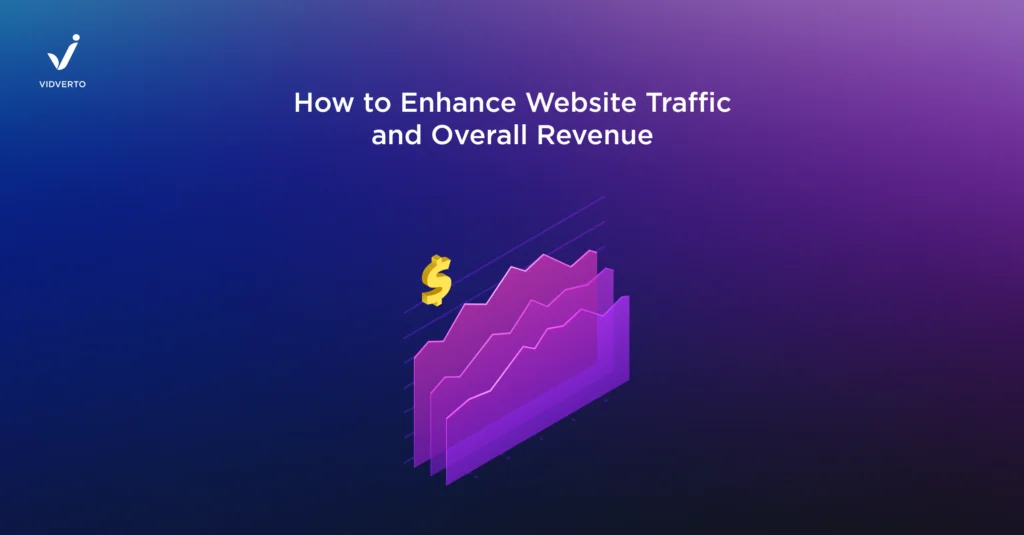How to Enhance Website Traffic and Overall Revenue

Driving traffic to publishers’ websites is critical in increasing overall monetization. It involves adapting a multifaceted approach, focusing on content optimization, strategic advertising, and leveraging data. This article serves several recommendations, enriched by Vidverto’s insights, to help publishers increase their website’s traffic and revenue streams.
- SEO Compliance and Social Media Engagement
Creating engaging content and implementing common SEO practices not only enhances search engine rankings but also boosts website visibility. Another recommendation is to constantly maintain your online presence by regularly sharing website content, participating in relevant discussions, and running targeted social media campaigns.
- Monetization through Strategic Advertising
After optimizing the website content and setting up social media strategies, you need to focus on monetization through display and programmatic advertising. Vidverto offers expertise in selecting and implementing the most effective ad formats for your needs, monitoring performance, and providing ongoing support.
Particularly effective ad formats are:
- Sticky: Remain fixed on the screen as users scroll. For its feature, sticky effectively achieves increased engagement and high viewability rates. This was particularly noticeable when implemented on econostrum.info, hetrik.sk, and xristika.gr, resulting in a 100% fill rate. Through this strategic implementation, Vidverto not only maximized ad space utilization but also boosted the ad revenue for these websites.
- InRead: This interactive ad format is placed directly within the body of your content. As users scroll through the page, inRead can transit into a sticky format, ensuring continued visibility and engagement. Once both formats are implemented, ad viewability and overall revenue tend to increase.
- Reach Media Ads: Unlike traditional static ad formats, this one engages users with immersive elements such as video and audio, leading to higher click-through rates and conversions. Additionally, allows advertisers to communicate their brand message in a more impactful and creative manner.
- Optimal Ad Placement
Research indicates that ads placed just above the fold or after the second paragraph on a page ensure maximum visibility. A viewability rate above 70% is considered good, as it unlocks more advertiser demand and can increase ad revenue for publishers.
For the best performance, place two ads at the top of the page, and avoid displaying ads on non-content pages like ‘About us’ and ‘Contact’.
Furthermore, take advantage of high-engagement areas on your site by placing ads alongside them. Vertical ad units, such as 160×600 pixels, are more viewable as they stay in view while users scroll. Responsive ad units that adapt to different screen sizes can further enhance viewability, making them suitable for both desktop and mobile platforms.
- Reducing Latency
A fast-loading website is essential, as slow-loading pages can lead to a poor user experience, high bounce rates, and ads that don’t render in time. Ads need to load with the rest of the webpage within 2–3 seconds, as users rarely wait for them.
Minimizing latency increases the chances of ads being seen, comprehended, and clicked. Tips to reduce latency include optimizing ad content, using asynchronous loading techniques, and limiting the number of ads per page (around two ads) to balance monetization with user experience.
- Adherence to Standards and Regulations
Complying with industry standards like those set by the Interactive Advertising Bureau (IAB) and data privacy regulations is critical. Non-compliance can result in penalties, ad removal, or demotion. Common Google policy violations include accidental clicks, using bots for artificial clicks, and non-compliant ad placements.
In the context of GDPR, using a Consent Management Platform (CMP) to manage user consent for data processing is particularly relevant. However, adopting CMPs doesn’t guarantee compliance with Google’s EU User Consent Policy.
By adhering to these recommendations, publishers can significantly enhance user engagement and ad viewability, which is pivotal for effective monetization. Vidverto supports publishers with campaign setup, from strategy implementation to ongoing ad management, ensuring that every campaign achieves its highest potential.







.svg)













